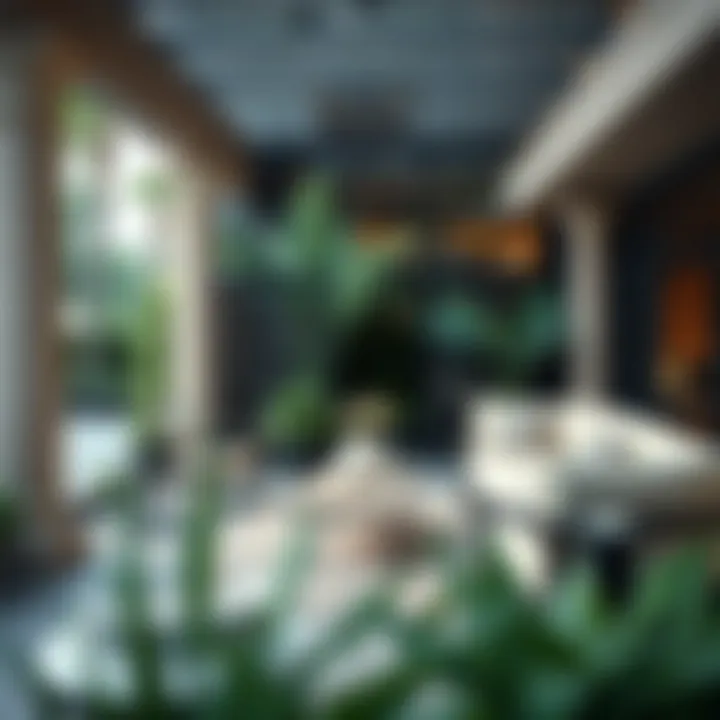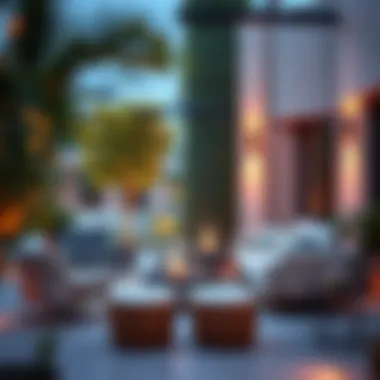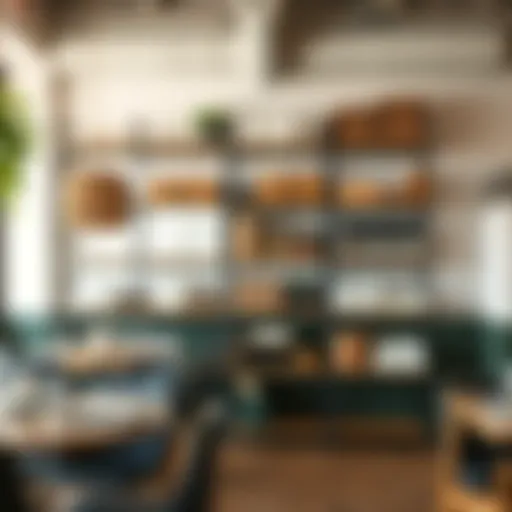Patio Furniture Conversation Pieces for Outdoor Elegance


Intro
Creating an inviting outdoor space is not simply about having a few chairs and a table under the open sky. The essence of crafting a meaningful patio lies in selecting conversation pieces—those unique items that don’t just serve a function, but also spark dialogue among guests and elevate the overall aesthetic. Think of a bold sculpture, an ornate fire pit, or a chic lounge chair that draws attention and encourages people to gather around it. These aren’t just furnishings; they are the heart of social interactions in an outdoor setting.
The importance of these discussion-generating pieces is multilayered. They transform outdoor spaces into a canvas for creativity and a stage for connection, whether among family during a weekend barbecue or friends during a casual late-night gathering. This article delves into the world of patio furniture conversation pieces, exploring the latest design trends, material choices, and the functional aspects that make these pieces indispensable for any outdoor oasis.
Let's consider how to enhance these outdoor areas by looking closely at current design trends that cater to both functionality and aesthetics.
Design Trends
As outdoor spaces evolve, so does the furniture that occupies them. Homeowners and designers alike now focus on creating rich experiences through smart design choices. In doing so, we see a shift towards both contemporary styles and thought-out color palettes.
Contemporary Styles
Today’s conversation pieces might feature sleek lines and minimalist forms. Items like modular sofas that can easily adapt to changing social dynamics are rising in popularity. Not only do these designs look modern, but they also allow for flexible seating arrangements that encourage interaction.
Consider, for example, the introduction of round fire pits surrounded by integrated seating. This kind of arrangement promotes intimacy, allowing everyone to feel included in the conversation. Materials used in contemporary designs often include weather-resistant metals and synthetic textures that mimic the elegance of wood without the upkeep.
Color Palettes and Materials
Color choices play a crucial role in setting the mood of an outdoor space. Subtle earth tones like muted greens and soft browns can create a calming environment. But don’t shy away from bold hues—think vibrant turquoise or deep maroon—that catch the eye and become a focal point.
Materials used today range from traditional teak and eucalyptus to more innovative options like recycled plastics or powder-coated metals. These selections enhance the durability of furniture while aligning with a growing trend of sustainability.
"The right choice of colors and materials not only enhances the beauty of outdoor spaces but also speaks volumes about the homeowner's personality."
Moreover, textures add depth; think woven baskets or patterned cushions that invite people to sit down and relax for a while. As we transition from design inspirations to functional solutions, we can further explore how comfort and practicality drive the choices in our outdoor spaces.
Functional Solutions
In addition to visual appeal, conversation pieces must fulfill practical needs. They can’t just look good; they need to support comfort and efficiency in use.
Ergonomic Furniture
One of the most significant considerations in patio furniture is ergonomics. Properly designed chairs, lounges, and tables can make or break an experience in your outdoor retreat. When picking pieces, consider how they will hold up over long hours of use. Look for furniture that’s designed with the human body in mind—slightly curved seats, adequately proportioned backs, and supportive armrests. Both comfort and functionality can lead to an increase in the time spent outdoors.
Space Optimization Tips
Outdoor areas often come with their own set of spatial limitations. Clever choices in furniture design can vastly improve how these spaces are utilized. Folding chairs and nesting tables enable you to make the most of smaller patios, while multipurpose pieces—like benches with storage—can serve dual functions.
When planning your layout, try to maintain clear pathways to avoid the cramped feeling found in too many cluttered areas. By strategically placing conversation pieces to punctuate your space, you encourage natural movement and bring life to otherwise underused corners.
Understanding the Concept of Conversation Pieces
When it comes to patio furniture, one term that often surfaces is conversation pieces. These are the standout items designed not only for comfort but to draw attention and incite discussions among those who use the space. Understanding this concept is fundamental as it lays the groundwork for a well-designed outdoor area. Unlike standard furnishings, conversation pieces carry weight in their aesthetics and functionality, often being the focal points around which gatherings thrive.
Defining Conversation Pieces in Furniture
Conversation pieces in patio furniture are distinct selections that provoke curiosity or stimulate social interaction. They can be anything from uniquely shaped chairs, vibrant sculptures, to oversized coffee tables that dictate the arrangement of the surrounding pieces. Generally speaking, they have a few key characteristics:
- Unusual Design: These items often flaunt unique shapes, patterns, or colors that stand out from typical furniture, making them visually striking.
- Comfort and Practicality: Though flashy, they also need to serve a purpose; whether it’s a cozy seating arrangement or a multifaceted piece, practicality cannot be overlooked.
- Social Invitation: They encourage people to gather around them. A fire pit, for instance, invites friends to sit and chat and share stories.
Defining these pieces and understanding their intent helps one appreciate their significance in outdoor aesthetics. They’re not merely furniture but a means to foster experiences and connections.
The Role of Conversation Pieces in Outdoor Spaces
Incorporating conversation pieces into outdoor spaces can transform the ambiance altogether. When a striking piece catches the eye, it can set the tone for the entire area. Here are some notable roles these items play:
- Fostering Interaction: Well-placed conversation pieces create natural gathering spots. When seating is arranged around a standout item, it encourages engagement among users. A circular arrangement may foster inclusivity, while an aligned setup can channel focused discussions.
"The placement of conversation pieces can nearly guarantee that guests feel welcome, promoting connections with an ease that simply can’t be manufactured."
- Enhancing Aesthetic Appeal: They can act as artistic elements within a landscape, combining beauty with purpose. For instance, an eye-catching bench or an intricately designed table can elevate a mundane patio into a chic outdoor parlor.
- Creating Themes or Narratives: The choice of conversation pieces also reflects personal style and storytelling. A rustic wooden swing provides a country charm, while a sleek metal sculpture might suggest modern minimalism. These selections indicate intentions behind the space and can invite deeper conversations.
In essence, understanding conversation pieces requires not only an appreciation for their design but also a recognition of their impact on social dynamics in outdoor settings. They are more than just furniture; they are central to an inviting atmosphere that encourages interaction and satisfaction.
The Significance of Patio Furniture in Outdoor Living
Patio furniture plays a vital role in transforming outdoor spaces into comfortable extensions of our homes. It isn't merely about aesthetics; it’s about creating environments where life happens—where friendships blossom and family gatherings are enjoyed. The significance of patio furniture stretches beyond physical structure; it serves to define our outdoor living experiences.


One of the prime benefits of patio furniture is its role in enhancing social interactions. When you arrange comfortable seating and style it to fit your environment, you invite conversations. A thoughtfully chosen set of chairs and tables can create a welcoming atmosphere, enticing friends and family to share stories and laughter. This leads to a stronger community bond and enriches the concept of outdoor living.
Moreover, lush greenery combined with functional patio furniture can create a retreat from the chaotic pace of daily life. Many people find tranquility in nature, and having a designed outdoor space allows for repose, contemplation, and appreciation of the environment. This means patio furniture is not just a luxury but an essential aspect of creating a mini sanctuary right outside our doors.
Historical Context of Patio Furniture
Understanding the historical evolution of patio furniture provides valuable insight into its significance today. The trend began in the 19th century when Victorian-era influences popularized the use of astronomical gardens, which necessitated elegant outdoor seating options that complemented the surrounding beauty. Wrought iron and cast aluminum became favorites during this period, representing both durability and artistic expression.
As time passed, the mid-20th century saw a surge in the use of plastic and lightweight materials, making patio sets widely accessible. The public's increased interest in backyards as extensions of their living spaces during this era solidified the importance of patio furniture in American culture. Back then, items like the classic folding chair were not just functional but also became symbols of leisure and enjoyment, echoing the lifestyle needs of the time.
Contemporary Trends in Patio Design
In today’s world, patio furniture has seen a transformation of sorts. Contemporary trends highlight a blend of functionality and artistry. Many individuals focus on creating outdoor rooms with distinct purposes—dining areas, lounging spots, or even cooking spaces complete with outdoor kitchens. These spaces speak volumes about personal style while using nature as a backdrop.
Technological advancements have introduced weather-resistant materials and smart designs that further elevate outdoor living spaces. For instance, modular furniture has become a popular choice, allowing homeowners to adapt seating arrangements based on gatherings or personal preference. Sustainable options, such as reclaimed wood or recycled plastics, are also gaining traction, reflecting a society increasingly passionate about environmental preservation.
"Patio furniture isn't just about comfort; it's about creating memories, building relationships, and enhancing our connection to nature."
Materials and Their Impact on Design
When it comes to crafting an inviting outdoor space, the materials utilized in patio furniture can have a significant influence on aesthetics, durability, and conversation. Selecting the right materials goes beyond mere function; it sets the tone for the area, engages the senses, and encourages social interaction. A well-rounded understanding of these materials can help homeowners, designers, and retailers make informed choices that enhance their outdoor environments.
Wooden Conversation Pieces
Wooden patio furniture holds a special place in outdoor design. With its natural warmth, it invites relaxation and fosters connection. There is a variety of woods to consider, including cedar, teak, and mahogany—each offering unique characteristics.
- Aesthetic Appeal: The visual texture of wood, ranging from rich grains to smooth finishes, can complement any theme from rustic to modern. The organic look makes it easier to blend with greenery, creating harmony in the garden.
- Durability and Treatment: While wood is beautiful, it's important to choose types that withstand the elements. Teak, for instance, has natural oils that repel water and resist decay. Regular treatment with sealants can prolong the lifespan of wooden pieces.
- Sustainability: Homeowners today lean towards eco-conscious choices. Sourcing wood from sustainable forests can be an attractive selling point, appealing to those who prioritize the environment.
"Wooden furniture is not just an item; it’s a statement of style and a testament to nature’s elegance in any setting."
Metal and Resin Options
Metal and resin are now ubiquitous in patio furniture design, presenting both robust solutions and sleek aesthetics. These materials offer advantages in maintenance and versatility.
- Metal Durability: Materials like aluminum and wrought iron boast amazing durability. They withstand harsh weather conditions, while offering easy maintenance. Cast aluminum, for instance, is lightweight yet sturdy enough for various designs.
- Resin for Comfort and Variety: Resin wicker, made from synthetic materials, mimics the look of natural wicker without the downsides. It's resistant to fading and cracking, making it perfect for sunny locations. Plus, designs can be playful and eclectic, catering to a range of styles.
- Innovative Designs: Metal and resin pieces can come in various shapes and sizes, allowing for creative experimentation in design. This flexibility can turn ordinary outdoor spaces into extraordinary environments enriched with style.
Fabric Choices for Cushioning
The fabric adds not just comfort but also a splash of personality to patio furniture. The right fabric choices are essential for enhancing usability without sacrificing style.
- Weather-resistant Fabrics: When selecting fabrics, it’s crucial to go for options labeled as weather-resistant or waterproof. Textiles such as solution-dyed acrylic are popular because they don’t fade easily and can handle moisture well.
- Comfort First: A well-cushioned seat makes all the difference. Look for cushions with high-density foam that keeps their shape while providing comfort for prolonged use during social gatherings.
- Color and Pattern: Fabrics provide an opportunity to express personal style. Bright colors and bold patterns can create a lively atmosphere, while neutral tones can make for a more serene setting. The flexibility in fabric choices allows homeowners to easily refresh their space without a complete overhaul.
In summary, the selection of materials for patio furniture is not merely a practical consideration but a profound aspect of outdoor design. Each material has distinctive qualities that influence not only the durability and aesthetic appeal of furniture but also its ability to foster social ties and create memorable experiences.
Design Styles that Foster Conversation
The style of patio furniture plays a pivotal role in creating an inviting outdoor space. Selecting appropriate design styles fosters social interactions and encourages gatherings. Understanding various designs helps homeowners and professionals craft environments that not only look good but also feel right. The choices you make resonate throughout the space, impacting comfort, flow, and ultimately, the conversations that unfold within it.
Traditional and Rustic Designs
Traditional and rustic designs bring warmth and a sense of history to outdoor spaces. Picture a solid wood dining set, complete with weathered finishes and intricate carvings; it’s the kind of furniture that tells a tale. These styles often incorporate natural materials, such as wood or stone, and bring an organic feel to your environment. The characteristics of this design foster familiarity among guests, creating a down-to-earth aesthetic.
- Comfort: Low-slung chairs and broad tables invite people to linger, encouraging discussions to flow as easily as the wine.
- Warmth: Natural finishes and earthy colors create a welcoming environment. Guests might feel more at home surrounded by wooden accents and hues of brown or green.
- Connection to Nature: Rustic designs often blend seamlessly with gardens or landscapes, making it easy for conversations to extend toward the beauty of the outdoors.
This style works brilliantly for informal gatherings, barbecues, or even a cozy dinner under the stars—setting the stage for tales and laughter to unfold.
Modern and Minimalistic Approaches
In stark contrast, modern and minimalistic designs bring sophistication and clean lines to the table. Think of sleek metal frames with chic cushions or streamlined loungers that radiate a crisp elegance. These pieces often feature neutral color palettes—whites, blacks, or grays, which allow other elements of the decor to pop. There’s a refined simplicity here that can amplify outdoor conversations by keeping the focus on the people involved.
- Functionality: Modern designs often embrace multi-functional roles. A table that expands or collapses can effortlessly adapt to the number of guests, minimizing space clutter while maximizing interaction.
- Aesthetic Appeal: The sleekness of modern furniture fosters an aura of calm and order. This kind of design can bring a zen-like quality to outdoor spaces, encouraging centered and focused conversations.
- Trendy Visuals: Embracing the latest styles, modern designs can impress guests while encouraging new discussion topics—from the trends themselves to material choices.
Ideal for contemporary gatherings or formal outdoor dinners, this style elevates the conversation to reflect intelligence and aesthetic awareness.
Eclectic and Bohemian Aesthetics
On the flip side, eclectic and bohemian aesthetics are a dazzling riot of colors and textures. Diverse styles converge, presenting an atmosphere brimming with creativity and spontaneity. Think mismatched chairs, vibrant cushions, and artful installations scattered about. This style invites guests to express themselves freely, establishing an open forum for discussions that meander like a winding river.
- Inspiration: This aesthetic draws influence from various cultures and time periods, sparking conversations about art, travel, and personal experiences. Each piece tells a story, and the collection itself can be a point of discussion.
- Diversity of Use: With varied seating options—such as hammocks, poufs, or even Moroccan-style benches—guests can choose their seating according to their comfort, which enhances their willingness to engage.
- Casual Charm: The mismatch reflects a casual vibe that puts people at ease. Guests may feel more inclined to share their ideas and experiences in a less structured setup.
Perfect for relaxed gatherings, cozy bonfires, or laid-back summer soirées, this design style encourages an easy flow of dialogue, enriching the atmosphere with vibrant energy.


Functionality Meets Aesthetics
Creating an outdoor space that resonates with beauty yet serves practical purposes is akin to striking a delicate balance. In the realm of patio furniture, the integration of functionality with aesthetics can transform an ordinary backyard into a captivating haven. These pieces aren't just about being eye-catching; they need to perform. Choosing patio furniture that fulfills specific roles while being visually appealing sets the stage for memorable outdoor encounters.
Multi-functional Furniture Pieces
In today’s fast-paced world, space is often at a premium. This is where multi-functional furniture pieces shine. Imagine a stylish bench that doubles as storage; it's not only a conversation starter but also a smart choice for keeping your outdoor area neat and tidy. Similarly, consider a coffee table that can transform into a dining surface or a chaise lounge that converts into a bed for those unexpected overnight guests.
These designs marry function with form. For example, outdoor Ottomans can serve as extra seating, a footrest, or even a small table when topped with a tray. These versatile pieces reflect the trend for adaptable living spaces, catering to various needs without compromising style. They reflect a thoughtful approach to design that acknowledges how life happens—spontaneously and often unexpectedly.
"The finest furniture isn’t just made to be looked at; it’s crafted to be lived on."
Space Optimization Techniques
Incorporating space optimization techniques is essential, especially in smaller patios or balconies. One effective method is using nesting tables, which can easily be tucked away when not in use but become valuable surfaces for food and drinks during gatherings. Another technique involves selecting furniture that can be easily moved around. Lightweight options allow homeowners to reconfigure their space quickly, ensuring it adapts to the occasion.
Moreover, utilizing vertical spaces can optimize layout. Installing wall-mounted shelves or planters can free up valuable floor area. This strategy allows for a clutter-free environment, making those cozy conversations flow smoother. Placement matters too; creating an intimate corner with a few comfortable chairs around a fire pit encourages dialogue and connection, while wide, open layouts might spread people out too thinly.
Psychology of Outdoor Interactions
When it comes to outdoor spaces, the psychology of interactions isn't just about having a seat and a table. It's about understanding how people engage, communicate, and revel in their surroundings. Recognizing the nuances of social behavior can elevate an outdoor space from mere functionality to an inviting haven that encourages conversations and connections.
Outdoor spaces, equipped with the right conversation pieces, can stir emotions and foster bonds. These interactions lead to memories that linger long after the sun sets and the last guests leave. Therefore, paying heed to the psychology behind these interactions is crucial for anyone looking to design or enhance an outdoor area.
Creating a Welcoming Atmosphere
Having a welcoming atmosphere in your patio is akin to opening your arms wide for friends and family. The right furniture can create a setting that feels inclusive and relaxed. This involves selecting furniture pieces that are not just aesthetically pleasing but also functional and approachable. For example, opting for rounded sofas or armchairs with soft cushions lends a homey feel, beckoning people to sit, chat, and be themselves.
It’s important to consider elements like color, arrangement, and materials. Warm tones or pastel shades evoke calmness and joy, while durable materials send a message of resilience. Adding touches like string lights or subtle garden features can accentuate the atmosphere further, enticing guests to linger longer. A well-decorated outdoor lounge makes people feel welcome and comforted, fostering conversations that flow naturally.
The Importance of Layout in Fostering Communication
The layout of an outdoor space can significantly affect how people interact within it. Thoughtfully planned gatherings turn moments into memories, and the arrangement of furniture is pivotal. It’s not always about how much you have but rather how it’s set up.
Circle vs. Straight Arrangements
In seating arrangements, a circle formation has a unique advantage. Unlike straight rows of chairs that may appear cold, a circular setup invites participants to face one another, encouraging dialogue and engagement. This familiar formation evokes a village gathering and naturally sparks interaction. The emphasis on inclusivity makes it a favored choice among designers.
On the flip side, straight arrangements can sometimes create barriers, making interaction feel more presidential than personal. However, they could work well in more formal settings where structure is essential. Ultimately, a circle fosters intimacy, creating a space where everyone feels equally valued and connected.
Use of Fire Pits and Central Features
Incorporating fire pits or central features can significantly enhance the dynamic of an outdoor space. They act as natural focal points, drawing people together. Picture this: a flickering flame, warm ambiance, and lively discussions—a perfect recipe for a memorable evening. Fire pits encourage encirclement, enhancing the sense of community and shared experience.
Central features like fire pits also provide warmth on chilly evenings, allowing for use year-round. They can transform an outdoor setting into a cozy retreat, where storytelling thrives, and laughter echoes long into the night. Yet, one must consider safety and proper spacing to avoid overcrowding the area.
In summary, thoughtful layout and the inclusion of natural elements can significantly enhance social interactions in outdoor spaces. The aim should always be to create environments that inspire connection, communication, and ultimately, cherished moments.
Selecting Conversation Pieces for Your Space
Selecting the right conversation pieces for your patio is more than a simple task; it's about crafting an atmosphere that invites interaction and connection. The furniture you choose speaks volumes about your personal taste, lifestyle, and intentions for the space. It’s crucial to approach this selection with a thoughtful mindset, considering not just aesthetics, but also how these elements come together to create an inviting outdoor experience.
Assessing Personal Style and Functionality
When it comes to determining personal style, it’s like peeling an onion – layers upon layers of preference and personality await. Start by asking yourself how you envision your patio space functioning. Are you looking for a playful area where kids can run wild, or a sophisticated setting for candlelit dinners?
Functionality plays a major role in decision-making. Each piece of furniture should not only look nice, but it must also serve a purpose. For instance, a swing chair offers a cozy nook for reading, while a dining set may be perfect for hosting family gatherings. Evaluate your lifestyle needs:
- Casual Gathering: Opt for comfortable, easy-to-move options like modular sofas or bean bags.
- Elegant Affairs: Choose refined items like wrought iron tables and dining sets with cushioned seating.
- Family Fun: Consider durable materials that tolerate spills and scratches for those lively get-togethers.
Think outside the box; perhaps a vintage trunk can serve as both a coffee table and storage. Making choices rooted in personal style while also addressing practical needs can ensure that your selections truly resonate with you and suit your life.
Considering Size and Scale
The size and scale of patio furniture in relation to the space available can make or break the look and feel of your outdoor retreat. You wouldn’t wear a size too small if you aim to impress; the same goes for your patio. Here are some key pointers to navigate this crucial aspect:
- Measure Twice, Buy Once: Take precise measurements of your patio area. This will prevent you from falling in love with a dining table only to find it dominates the whole space.
- Proportions Matter: The furniture should harmonize with the dimensions of your patio. If your space is small, lightweight items that can be tucked away when not in use might be ideal. Meanwhile, a larger area might call for more substantial pieces, such as a sectional sofa or a coffee table that commands attention.
- Flow and Movement: Does your patio allow for easy movement? You don’t want guests bumping into furniture while carrying their drinks. Aim for a comfortable flow of space, ensuring that chairs and tables maintain a good distance.
- Scale of Use: Finally, consider the number of people who regularly use the space. If you frequently host events, large sectional sofas or expandable tables can be versatile choices to accommodate extra guests without sacrificing comfort.
"Furniture selection is not merely about choices—it’s about crafting an experience of gathering and community."


In selecting conversation pieces for your space, it’s all about harmonizing personal style with the practical aspects of functionality and scale. Thoughtful consideration will help transform your patio into an inviting sanctuary that sparks connection while showcasing your unique taste.
Maintenance and Longevity of Patio Furniture
In the realm of outdoor living, the longevity and upkeep of patio furniture cannot be overstated. It isn’t just about how your space looks today, but how it will fare against the elements and wear over time. Proper maintenance is an investment that can prolong the lifespan of your conversation pieces, ensuring they remain as inviting as when you first set them out. This section dives into best practices for keeping your furnishings in top condition, highlighting why caring for your outdoor pieces is essential for both aesthetics and functionality.
Cleaning and Care Tips
Regular cleaning is the cornerstone of furniture maintenance. Don’t leave your beautiful patio furniture to battle nature’s wrath alone. Rather, a little TLC goes a long way. Follow these tried-and-true tips:
- Dust and Debris Removal: Start by using a soft cloth or a duster to remove dirt. It's better to tackle grime before it settles.
- Seasonal Deep Cleaning: Depending on the material, a deep clean may be necessary a few times a year. For wooden pieces, a gentle soap solution and soft brushes work wonders. Metals may need a specific cleaner to prevent rust, while resin furniture often can be cleaned with just mild soap and water.
- Protective Covers: Investing in quality furniture covers can save time on regular cleaning and reduce wear caused by weather exposure. Covering your pieces when not in use shields them from rain and UV rays.
Consequently, keeping everything spick-and-span helps prevent the buildup of grime that can lead to staining or a decrepit appearance over time. As the saying goes, an ounce of prevention is worth a pound of cure.
Weather Resistance and Durability
Selecting the right materials at the outset can save you a ton of hassle later. While many patio furniture sets boast great looks, it’s the quality of the materials that determine their durability.
- Timber Treatments: If you opt for wooden furniture, like teak or eucalyptus, ensure it has undergone proper weather treatment. Applying sealants for additional protection can keep the grain intact and prevent splintering and fading.
- Metal Choices: Aluminum is light and resistant to corrosion, making it a go-to for outdoor settings. On the other hand, wrought iron, while sturdier, may require a bit more attention to avoid rusting.
- Resin Benefits: Synthetic resin furniture, often made from high-density polyethylene or polystyrene, is highly resistant to fading and moisture. This makes resin pieces not only stylish but also low-maintenance and long-lasting.
Ensuring your patio furniture is made from materials that can withstand various weather conditions is key. With the right choices, you won’t have to worry about replacing your favorites every few seasons.
Remember: Durability should be the linchpin of any outdoor furniture shopping spree - prioritize materials that promise resilience against sun, rain, and whims of weather.
Taking these steps allows homeowners to enjoy their patio areas year after year, creating that ever-important inviting atmosphere where friends and family gather, without the stress of constant replacements or repairs. The balance of aesthetics and durability is crucial in achieving a space that not only looks good but feels good to inhabit.
The Future of Patio Furniture Design
The design of patio furniture continues to evolve, reflecting the shifting expectations of homeowners and outdoor enthusiasts. The upcoming trends emphasize sustainability and the integration of technology, pushing the boundaries of materials and functionality. As the world becomes more environmentally aware, the choices we make for our outdoor spaces will significantly influence not just aesthetics but also long-term effects on the planet. Shaping the future patio environments will reflect individual styles while also adhering to a greater ethical responsibility towards our surroundings.
Emerging Trends in Sustainability
Sustainability is no longer just a buzzword; it has become a guiding principle in furniture design. Homeowners are becoming increasingly conscious about their environmental footprint, prompting designers to innovate. Here are several aspects that underline the significance of this movement:
- Reclaimed Materials: Utilizing recycled wood or metal gives new life to old materials, providing a rustic charm while minimizing waste. Furniture pieces made from reclaimed barn wood or ocean debris showcase the beauty of imperfections and tell a story.
- Eco-friendly Production Methods: Manufacturers are adopting techniques that reduce energy consumption and waste during production. For instance, waterborne finishes and low-impact dyes are replacing harsher chemicals, ensuring a safer environment for both the maker and the user.
- Sustainable Accessories: Beyond furniture, outdoor accessories play a vital role in design and sustainability. Consider Biodegradable planters or solar-powered lights that enhance not just functionality, but also the eco-credentials of your outdoor space.
"Investing in sustainable patio furniture is akin to planting a seed for the future."
Technological Innovations in Materials
Technology has taken patio furniture design by storm, introducing materials and processes previously thought improbable. Here’s how:
- Performance Fabrics: New advancements in textiles mean that outdoor cushions can now repel water, resist fading, and are easier to clean. Sunbrella is a brand setting the standard for durability while maintaining style.
- Smart Furniture: Incorporating technology into furniture makes outdoor space more functional and enjoyable. For example, furniture that includes wireless charging capabilities or built-in speakers can take gatherings to another level.
- 3D Printing: This technology allows for highly customizable furniture options. With 3D printing, unique designs tailored to individual preferences can be produced, reducing waste, as only the needed material is used.
Culmination: The Art of Selecting Conversation Pieces
Selecting the right conversation pieces for your outdoor space is not just an aesthetic choice; it’s an essential part of creating a welcoming atmosphere. The conversation piece can be the difference between a simple outdoor area and a vibrant space that invites engagement and interaction. A well-chosen furniture item doesn’t merely serve a functional purpose; it becomes a focal point where stories unfold and memories are created.
When selecting conversation pieces, consider these key elements:
- Functionality: Ensure that the furniture serves a purpose beyond being visually appealing. For example, a coffee table should not only look good but also accommodate snacks and drinks during get-togethers.
- Comfort: The comfort level of your seating options impacts how long guests linger in your space. Cushions with good support and materials that breathe well can enhance the experience.
- Style Cohesion: Choose pieces that blend well with the overall aesthetic of your patio, while still making a statement. An eclectic mix might work in some cases, but too many contrasting elements can create visual chaos.
Above all, consider the layout and how people will interact with one another. A circular arrangement can promote intimacy and dialogue, while traditional layouts might foster a more relaxed entertainment style.
Summing Up the Essentials
In summary, selecting conversation pieces involves a thoughtful assessment of functionality, comfort, and aesthetic coherence. It’s about piecing together various elements to create an outdoor space that resonates with you and your guests. Factors like size, style, and the materials used should always align with your vision for how you want your outdoor area to function.
- Key Takeaways:
- Prioritize functionality and comfort in all choices.
- Seek cohesive styles that resonate with your overall design.
- Don’t shy away from exploring various materials and layouts to find what works best.
The essence of conversation pieces lies in their role as catalysts for social interactions. They encourage people to gather, share stories, and cultivate connections.
An Invitation to Explore Aesthetic Balance
Creating a perfect aesthetic balance is an art in itself. It involves understanding the relationship between form, space, and color in your selections. Start by imagining how the conversation pieces will look against the backdrop of your garden or outdoor area. Natural elements, like greenery and sunlight, will influence how materials and colors are perceived.
Consider these pointers when seeking that balance:
- Natural Harmony: Select colors and materials that harmonize with the surrounding flora and architecture. Materials like teak or aluminum can complement outdoor settings beautifully.
- Contrasting Elements: Don’t be afraid to use contrasting colors or textures. A brightly colored chair can pop against a muted background, becoming a conversation starter itself.
- Movement and Flow: Design your outdoor space to allow easy movement. Avoid clutter and leave ample space between furniture pieces to encourage free-flowing conversation.
The goal is to create an area where every seating piece encourages dialogue and every element enhances the overall experience. While choosing your conversation pieces, keep in mind that they should be as much about aesthetics as they are about comfort and usability. In the end, the right arrangements will enhance your outdoor gathering, making it a more delightful experience for everyone involved.
"Selecting the right conversation piece is more than aesthetics; it’s about creating an inviting space that sparks joy and interaction."
For further insight into outdoor design principles, you can explore resources on Wikipedia or the insightful publications on Britannica. Additionally, discussions in communities like Reddit can provide fresh perspectives and ideas on patio design.















